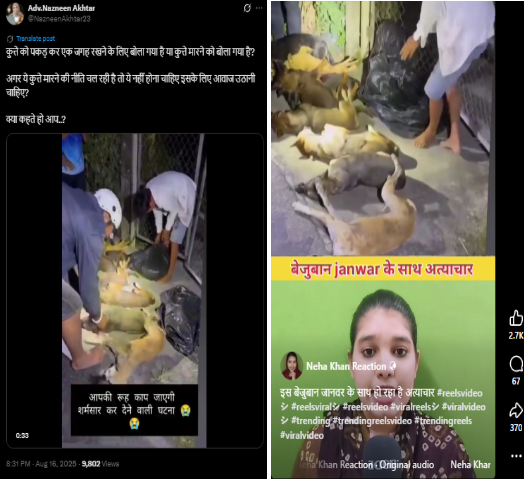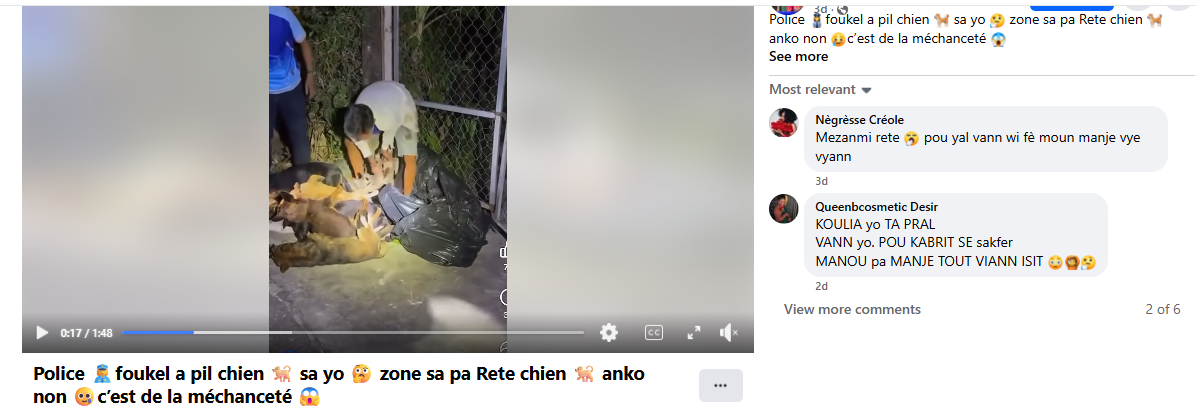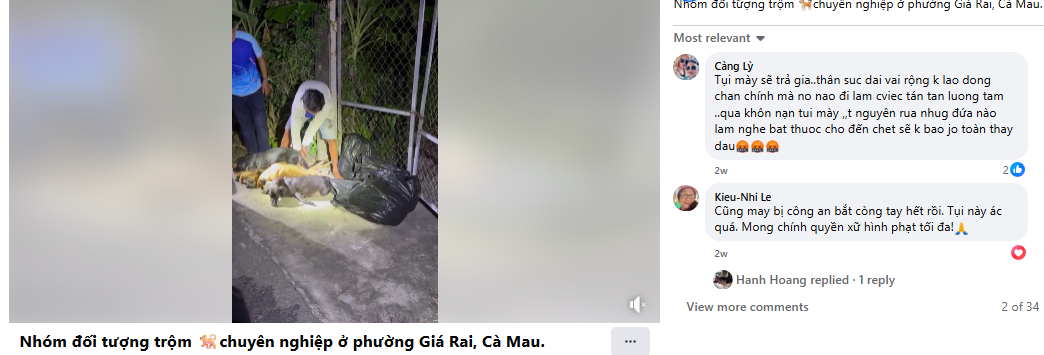#FactCheck: Fake Claim on Delhi Authority Culling Dogs After Supreme Court Stray Dog Ban Directive 11 Aug 2025
Executive Summary:
A viral claim alleges that following the Supreme Court of India’s August 11, 2025 order on relocating stray dogs, authorities in Delhi NCR have begun mass culling. However, verification reveals the claim to be false and misleading. A reverse image search of the viral video traced it to older posts from outside India, probably linked to Haiti or Vietnam, as indicated by the use of Haitian Creole and Vietnamese language respectively. While the exact location cannot be independently verified, it is confirmed that the video is not from Delhi NCR and has no connection to the Supreme Court’s directive. Therefore, the claim lacks authenticity and is misleading
Claim:
There have been several claims circulating after the Supreme Court of India on 11th August 2025 ordered the relocation of stray dogs to shelters. The primary claim suggests that authorities, following the order, have begun mass killing or culling of stray dogs, particularly in areas like Delhi and the National Capital Region. This narrative intensified after several videos purporting to show dead or mistreated dogs allegedly linked to the Supreme Court’s directive—began circulating online.

Fact Check:
After conducting a reverse image search using a keyframe from the viral video, we found similar videos circulating on Facebook. Upon analyzing the language used in one of the posts, it appears to be Haitian Creole (Kreyòl Ayisyen), which is primarily spoken in Haiti. Another similar video was also found on Facebook, where the language used is Vietnamese, suggesting that the post associates the incident with Vietnam.
However, it is important to note that while these posts point towards different locations, the exact origin of the video cannot be independently verified. What can be established with certainty is that the video is not from Delhi NCR, India, as is being claimed. Therefore, the viral claim is misleading and lacks authenticity.


Conclusion:
The viral claim linking the Supreme Court’s August 11, 2025 order on stray dogs to mass culling in Delhi NCR is false and misleading. Reverse image search confirms the video originated outside India, with evidence of Haitian Creole and Vietnamese captions. While the exact source remains unverified, it is clear the video is not from Delhi NCR and has no relation to the Court’s directive. Hence, the claim lacks credibility and authenticity.
Claim: Viral fake claim of Delhi Authority culling dogs after the Supreme Court directive on the ban of stray dogs as on 11th August 2025
Claimed On: Social Media
Fact Check: False and Misleading
Related Blogs

Introduction
The world has been surfing the wave of technological advancements and innovations for the past decade, and it all pins down to one device – our mobile phone. For all mobile users, the primary choices of operating systems are Android and iOS. Android is an OS created by google in 2008 and is supported by most brands like – One+, Mi, OPPO, VIVO, Motorola, and many more and is one of the most used operating systems. iOS is an OS that was developed by Apple and was introduced in their first phone – The iPhone, in 2007. Both OS came into existence when mobile phone penetration was slow globally, and so the scope of expansion and advancements was always in favor of such operating systems.
The Evolution
iOS
Ever since the advent of the iPhone, iOS has seen many changes since 2007. The current version of iOs is iOS 16. However, in the course of creating new iOS and updating the old ones, Apple has come out with various advancements like the App Store, Touch ID & Face ID, Apple Music, Podcasts, Augmented reality, Contact exposure, and many more, which have later become part of features of Android phone as well. Apple is one of the oldest tech and gadget developers in the world, most of the devices manufactured by Apple have received global recognition, and hence Apple enjoys providing services to a huge global user base.
Android
The OS has been famous for using the software version names on the food items like – Pie, Oreo, Nougat, KitKat, Eclairs, etc. From Android 10 onwards, the new versions were demoted by number. The most recent Android OS is Android 13; this OS is known for its practicality and flexibility. In 2012 Android became the most popular operating system for mobile devices, surpassing Apple’s iOS, and as of 2020, about 75 percent of mobile devices run Android.
Android vs. iOS
1. USER INTERFACE
One of the most noticeable differences between Android and iPhone is their user interface. Android devices have a more customizable interface, with options to change the home screen, app icons, and overall theme. The iPhone, on the other hand, has a more uniform interface with less room for customization. Android allows users to customize their home screen by adding widgets and changing the layout of their app icons. This can be useful for people who want quick access to certain functions or information on their home screen. IOS does not have this feature, but it does allow users to organize their app icons into folders for easier navigation.
2. APP SELECTION
Another factor to consider when choosing between Android and iOS is the app selection. Both platforms have a wide range of apps available, but there are some differences to consider. Android has a larger selection of apps overall, including a larger selection of free apps. However, some popular apps, such as certain music streaming apps and games, may be released first or only available on iPhone. iOS also has a more curated app store, meaning that all apps must go through a review process before being accepted for download. This can result in a higher quality of apps overall, but it can also mean that it takes longer for new apps to become available on the platform. iPhone devices tend to have less processing power and RAM. But they are generally more efficient in their use of resources. This can result in longer battery life, but it may also mean that iPhones are slower at handling multiple tasks or running resource-intensive apps.
3. PERFORMANCE
When it comes to performance, both Android and iPhone have their own strengths and weaknesses. Android devices tend to have more processing power and RAM. This can make them faster and more capable of handling multiple tasks simultaneously. However, this can also lead to Android devices having shorter battery life compared to iPhones.
4. SECURITY
Security is an important consideration for any smartphone user, and Android and iPhone have their own measures to protect user data. Android devices are generally seen as being less secure than iPhones due to their open nature. Android allows users to install apps from sources other than the Google Play Store, which can increase the risk of downloading malicious apps. However, Android has made improvements in recent years to address this issue. Including the introduction of Google Play Protect, which scans apps for malware before they are downloaded. On the other hand, iPhone devices have a more closed ecosystem, with all apps required to go through Apple‘s review process before being available for download. This helps reduce the risk of downloading malicious apps, but it can also limit the platform’s flexibility.
Conclusion
The debate about the better OS has been going on for some time now, and it looks like it will get more comprehensive in the times to come, as netizens go deeper into cyberspace, they will get more aware and critical of their uses and demands, which will allow them to opt for the best OS for their convenience. Although the Andriod OS, due to its integration, stands more vulnerable to security threats as compared to iOS, no software is secure in today’s time, what is secure is its use and application hence the netizen and the platforms need to increase their awareness and knowledge to safeguard themselves and the wholesome cyberspace.

Introduction
Beginning with the premise that the advent of the internet has woven a rich but daunting digital web, intertwining the very fabric of technology with the variegated hues of human interaction, the EU has stepped in as the custodian of this ever-evolving tableau. It is within this sprawling network—a veritable digital Minotaur's labyrinth—that the European Union has launched a vigilant quest, seeking not merely to chart its enigmatic corridors but to instil a sense of order in its inherent chaos.
The Digital Services Act (DSA) is the EU's latest testament to this determined pilgrimage, a voyage to assert dominion over the nebulous realms of cyberspace. In its latest sagacious move, the EU has levelled its regulatory lance at the behemoths of digital indulgence—Pornhub, XVideos, and Stripchat—monarchs in the realm of adult entertainment, each commanding millions of devoted followers.
Applicability of DSA
Graced with the moniker of Very Large Online Platforms (VLOPs), these titans of titillation are now facing the complex weave of duties delineated by the DSA, a legislative leviathan whose coils envelop the shadowy expanses of the internet with an aim to safeguard its citizens from the snares and pitfalls ensconced within. Like a vigilant Minotaur, the European Commission, the EU's executive arm, stands steadfast, enforcing compliance with an unwavering gaze.
The DSA is more than a mere compilation of edicts; it encapsulates a deeper, more profound ethos—a clarion call announcing that the wild frontiers of the digital domain shall be tamed, transforming into enclaves where the sanctity of individual dignity and rights is zealously championed. The three corporations, singled out as the pioneers to be ensnared by the DSA's intricate net, are now beckoned to embark on an odyssey of transformation, realigning their operations with the EU's noble envisioning of a safeguarded internet ecosystem.
The Paradigm Shift
In a resolute succession, following its first decree addressing 19 Very Large Online Platforms and Search Engines, the Commission has now ensconced the trinity of adult content purveyors within the DSA's embrace. The act demands that these platforms establish intuitive user mechanisms for reporting illicit content, prioritize communications from entities bestowed with the 'trusted flaggers' title, and elucidate to users the rationale behind actions taken to restrict or remove content. Paramount to the DSA's ethos, they are also tasked with constructing internal mechanisms to address complaints, forthwith apprising law enforcement of content hinting at criminal infractions, and revising their operational underpinnings to ensure the confidentiality, integrity, and security of minors.
But the aspirations of the DSA stretch farther, encompassing a realm where platforms are agents against deception and manipulation of users, categorically eschewing targeted advertisement that exploits sensitive profiling data or is aimed at impressionable minors. The platforms must operate with an air of diligence and equitable objectivity, deftly applying their terms of use, and are compelled to reveal their content moderation practices through annual declarations of transparency.
The DSA bestows upon the designated VLOPs an even more intensive catalogue of obligations. Within a scant four months of their designation, Pornhub, XVideos, and Stripchat are mandated to implement measures that both empower and shield their users—especially the most vulnerable, minors—from harms that traverse their digital portals. Augmented content moderation measures are requisite, with critical risk analyses and mitigation strategies directed at halting the spread of unlawful content, such as child exploitation material or the non-consensual circulation of intimate imagery, as well as curbing the proliferation and repercussions of deepfake-generated pornography.
The New Rules
The DSA enshrines the preeminence of protecting minors, with a staunch requirement for VLOPs to contrive their services so as to anticipate and enfeeble any potential threats to the welfare of young internet navigators. They must enact operational measures to deter access to pornographic content by minors, including the utilization of robust age verification systems. The themes of transparency and accountability are amplified under the DSA's auspices, with VLOPs subject to external audits of their risk assessments and adherence to stipulations, the obligation to maintain accessible advertising repositories, and the provision of data access to rigorously vetted researchers.
Coordinated by the Commission in concert with the Member States' Digital Services Coordinators, vigilant supervision will be maintained to ensure the scrupulous compliance of Pornhub, Stripchat, and XVideos with the DSA's stringent directives. The Commission's services are poised to engage with the newly designated platforms diligently, affirming that initiatives aimed at shielding minors from pernicious content, as well as curbing the distribution of illegal content, are effectively addressed.
The EU's monumental crusade, distilled into the DSA, symbolises a pledge—a testament to its steadfast resolve to shepherd cyberspace, ensuring the Minotaur of regulation keeps the bedlam at a manageable compass and the sacrosanctity of the digital realm inviolate for all who meander through its infinite expanses. As we cast our gazes toward February 17, 2024—the cusp of the DSA's comprehensive application—it is palpable that this legislative milestone is not simply a set of guidelines; it stands as a bold, unflinching manifesto. It beckons the advent of a novel digital age, where every online platform, barring small and micro-enterprises, will be enshrined in the lofty ideals imparted by the DSA.
Conclusion
As we teeter on the edge of this nascent digital horizon, it becomes unequivocally clear: the European Union's Digital Services Act is more than a mundane policy—it is a pledge, a resolute statement of purpose, asserting that amid the vast, interwoven tapestry of the internet, each user's safety, dignity, and freedoms are enshrined and hold the intrinsic significance meriting the force of the EU's legislative guard. Although the labyrinth of the digital domain may be convoluted with complexity, guided by the DSA's insightful thread, the march toward a more secure, conscientious online sphere forges on—resolute, unerring, one deliberate stride at a time.
References
https://ec.europa.eu/commission/presscorner/detail/en/ip_23_6763https://www.breakingnews.ie/world/three-of-the-biggest-porn-sites-must-verify-ages-under-eus-new-digital-law-1566874.html

Introduction
India’s telecom regulator, the Telecom Regulatory Authority of India (TRAI), has directed telcos to block all unverified headers and message templates within 30 and 60 days, respectively, according to a press release. The regulator observed that telemarketers were ‘misusing’ headers and message templates of registered parties and asked telcos to reverify all registered headers & message templates on the DLT (Distributed Ledger Technology) platform. All telecom service providers (TSP) have to comply with these directions, issued under the Telecom Commercial Communication Customer Preference Regulations, 2018, within a month, TRAI said in its release. The directions were issued after TRAI held a meeting with telcos on February 17, 2023, to discuss quality of service (QoS) improvements, review of QoS standards, QoS of 5G services and unsolicited commercial communications”, as per its press release.
Why it matters?
It may be useful as it can ensure that all promotional messages are sent through registered telemarketers using only approved templates. It is no secret that the spam problem has been difficult to rein in, so the measure can restrict its proliferation and filter out telemarketers resorting to misuse.
Details about TRAI’s orders
The release said that telcos have to ensure that temporary headers are deactivated immediately after the time duration for which such headers were created. The telcos also have to ensure that there is no space to insert unwanted content in the template of a message where one can add content to be sent to people. Message recipients should not be confused, so telcos must ensure that they register no lookalike headers in the names of different senders.
Measures to check unregistered telemarketers
The release ordered telcos to bar telemarketers not registered on its DLT platform from accessing message templates and scrubbing them to deliver spam messages to recipients on the telco’s network. The telcos have been directed not to allow promotional messages to be sent by unregistered telemarketers or telemarketers using 10-digit telephone numbers. It added that telcos have to take action against erring telemarketers and share details of these telemarketers with other telcos, which will then be responsible for stopping these entities from sending commercial communications through their networks.
How big is the problem of spam?
A survey conducted by LocalCircles said that two out of every three people (66 per cent) in India get three or more spam calls daily. It added that not one person among thousands of respondents checked the box of ‘no spam’.
The platform said that it was a national survey which gathered over 56,000 responses from Indians located in 342 districts. It also found that 92 % of responders said they continue receiving spam despite opting for DND. The DND list is a feature where mobile subscriber can register their number to avoid getting unsolicited commercial communication (UCC).
Addressing the problem of spam
The regulatory body recently released a consultation paper that proposed the idea of providing the real name identity of callers to people receiving calls. The paper said that it would use a database containing each subscriber’s correct name to implement the caller name presentation (CNAP) service. The regulator wants to use details acquired by telecom service providers via customer acquisition forms (CAF).
TRAI formed a joint committee to look at the issue of phishing and cyber fraud in 2022. It included officials from the Reserve Bank of India (RBI) and the Securities and Exchange Board of India (SEBI). The telecom watchdog had laid out a plan to combat SMS and call spam using blockchain technology (DLT). It saw telecom companies and TRAI to build an encrypted and distributed database that will record user consent to be included in SMS or call send-out lists.
According to a press release, the Telecom Regulatory Authority of India (TRAI), the telecom regulator in India, has ordered carriers to block any unverified headers and message templates within 30 and 60 days, respectively.
The regulator saw that telemarketers were “misusing” registered parties’ headers and message templates. Thus, they requested that telecoms validate all of the registered headers and message templates on the DLT (Distributed Ledger Technology) platform.
According to TRAI’s statement, all telecom service providers (TSP) must adhere to these directives within one month under the 2018 Telecom Commercial Communication Consumer Preference Rules. The guidelines were released following a conference with telcos convened by TRAI on February 17, 2023, to discuss quality of service (QoS) enhancements, a review of QoS standards, the QoS of 5G services, and unsolicited commercial communications.
Why it matters?
Requiring that only registered telemarketers send promotional communications using approved templates may prove to be a beneficial safeguard. It is no secret that the spam problem has been challenging to control, so the measure can limit its spread and screen out telemarketers that employ abusive tactics.
Information on the TRAI order
According to the press release, telecoms must ensure that temporary headers are deactivated as soon as the time period they were established has passed. The telecoms must also ensure that there is no room in the message template where one can add content to be sent to recipients for unwanted content. There should be no room for uncertainty among message recipients. Thus, telecoms must ensure that no similar-looking headers are registered under the identities of various senders.
Taking action against unregistered telemarketers In accordance with the directive, telcos must prevent telemarketers who are not registered on their DLT platform from obtaining message templates and using them to send spam to subscribers on their network. Telemarketers who are not registered or who use 10-digit phone numbers cannot send promotional messages, according to instructions given to telecoms. Telcos must take action against misbehaving telemarketers, it was noted, and divulge their information to other telecoms, who would be in charge of preventing these companies from transmitting commercial messages.
How widespread is the spam issue?
According to a LocalCircles poll, three or more spam calls are received every day by two out of every three Indians (66%) on average. It further stated that not a single one of the thousands of responses clicked the “no-spam” box. According to the platform, the survey was conducted nationally and received over 56,000 responses from Indians in 342 districts. Moreover, 92 % of respondents reported that even after choosing DND, they still receive spam. A mobile subscriber can register their number on the DND list to prevent receiving unsolicited commercial communication (UCC).
consultation document recently in which it recommended the concept of providing the genuine name identify of callers to persons receiving calls. The paper indicated that it would employ a database containing each subscriber’s correct name to implement the caller name presentation (CNAP) service. The regulator wants to use information collected by telecom service providers through client acquisition forms (CAF).
Conclusion
TRAI established a joint committee to examine the problem of phishing and cyber scams in 2022. Officials from the Securities and Exchange Board of India (SEBI) and Reserve Bank of India (RBI) were present (SEBI).
The telecom watchdog had outlined a strategy for leveraging blockchain technology to combat SMS and call spam (DLT).


